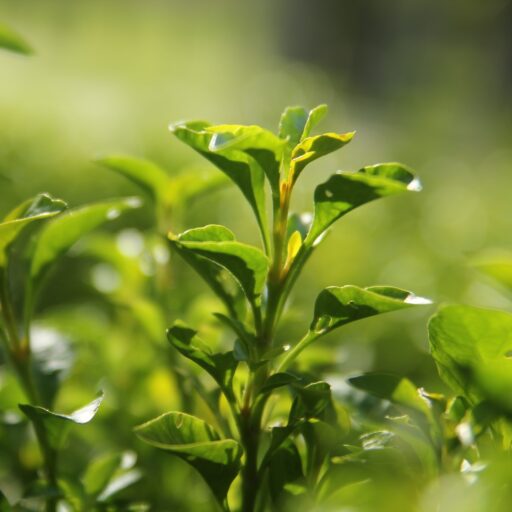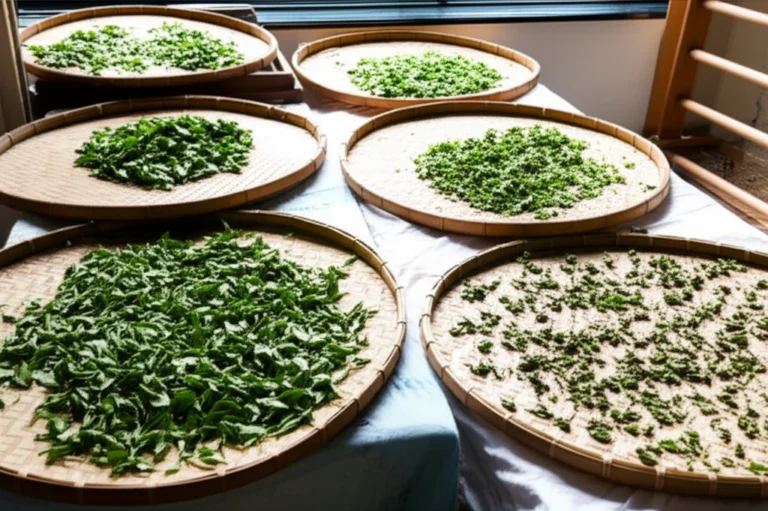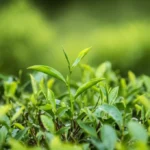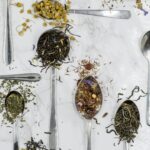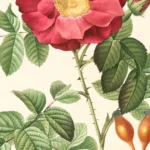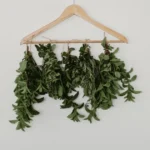Support our educational content for free when you purchase through links on our site. Learn more
10 Expert Tea Leaf Flavor Enhancement Tips You Need to Try! 🍃 (2025)
Ever wondered why some cups of tea taste like liquid gold while others fall flat or bitter? At Growing Teas™, we’ve spent years cultivating, tasting, and perfecting the art of coaxing the most vibrant flavors from tea leaves — whether you’re growing your own or brewing from premium leaves. Did you know that water quality can change your tea’s flavor more than the leaves themselves? Or that the right teaware can amplify subtle floral notes you never knew existed?
In this article, we’ll share 10 expert-backed tips to elevate your tea leaf flavor game, from mastering water temperature and steeping times to experimenting with natural enhancers and teaware choices. Plus, we’ll reveal insider secrets from our tea gardens that will have you brewing like a pro in no time. Ready to unlock the full potential of your tea leaves? Let’s dive in!
Key Takeaways
- Water quality and temperature are crucial for extracting the best flavors from your tea leaves.
- Steeping time and serving size adjustments can transform bitterness into balance.
- Choosing the right teaware preserves and enhances your tea’s natural aroma and taste.
- Experimenting with herbs, spices, and different tea varieties opens new flavor horizons.
- Proper cleaning and maintenance of your brewing tools ensure pure, uncontaminated flavor every time.
Stay tuned for detailed step-by-step guidance and pro tips that will make every cup a celebration of flavor!
Table of Contents
- ⚡️ Quick Tips and Facts for Enhancing Tea Leaf Flavor
- 🌱 The Art and Science of Tea Leaf Flavor: A Flavorful History
- 1. 🎯 Understand Your Palate: Tailoring Tea Flavor to Your Taste Buds
- 2. 💧 Water Quality Matters: Choosing the Best Water Source for Tea
- 3. 🔥 Mastering Water Temperature: Unlocking the Perfect Tea Flavor
- 4. ⏳ Steeping Time Secrets: How Long is Too Long or Too Short?
- 5. 🍵 Teaware Tactics: How Your Cup and Pot Influence Flavor
- 6. 📏 Adjusting Serving Size: Finding the Flavor Sweet Spot
- 7. 🌿 Experimenting with Different Tea Varieties: Expanding Your Flavor Horizon
- 8. 🧂 Enhancing Flavor with Natural Additives: Herbs, Spices, and More
- 9. 🧊 Cold Brew and Iced Tea: Flavor Enhancement Tips for Chilled Brews
- 10. 🧼 Cleaning and Maintenance: Keeping Your Equipment Flavor-Ready
- 💬 Share Your Tea Leaf Flavor Adventures: Leave a Comment!
- 🎉 Conclusion: Brewing the Ultimate Flavor Experience
- 🔗 Recommended Links for Tea Leaf Flavor Mastery
- ❓ FAQ: Your Burning Questions on Tea Leaf Flavor Enhancement
- 📚 Reference Links: Trusted Sources and Further Reading
⚡️ Quick Tips and Facts for Enhancing Tea Leaf Flavor
Welcome to the flavor lab of Growing Teas™! 🌿 Whether you’re cultivating your own tea or brewing from a trusted source, unlocking the full potential of tea leaf flavor is both an art and a science. Here’s a quick cheat sheet from our tea growers’ experience to get you started:
- Use fresh, whole loose leaves rather than dust or fannings for richer flavor and aroma. (Loose leaf tea is superior to bags — see our featured video for why!)
- Weigh your tea leaves for consistency — aim for about 1.5 to 2 grams per 8 oz (240 ml) of water.
- Adjust water temperature based on tea type: green teas prefer 160-175°F (70-80°C), black teas 200-212°F (93-100°C).
- Steep time matters: 1-3 minutes depending on tea and personal taste; longer steeping can cause bitterness.
- Use filtered or spring water — tap water minerals affect flavor dramatically.
- Try different teaware: glazed ceramic or glass pots preserve flavor better than metal or plastic.
- Experiment with natural enhancers: fresh herbs, citrus peels, or spices can elevate your cup.
Fun fact: The flavor profile of tea leaves can change yearly due to weather and harvest timing, so your favorite tea might surprise you from season to season!
For a deep dive into each of these tips, keep reading — we’ll spill all the tea on how to make your brew sing! 🎶
🌱 The Art and Science of Tea Leaf Flavor: A Flavorful History
Tea flavor isn’t just a matter of leaves meeting water — it’s a centuries-old dance of cultivation, processing, and brewing techniques that shape every sip. At Growing Teas™, we’ve seen how terroir, leaf handling, and even the tiniest environmental shifts influence flavor complexity.
Origins of Flavor Development
- Camellia sinensis, the tea plant, originated in East Asia, where ancient farmers discovered that plucking young leaves at dawn yields the most delicate flavors.
- Over millennia, processing methods like withering, oxidation, rolling, and drying evolved to create distinct tea types — green, black, oolong, white, and pu-erh — each with unique flavor fingerprints.
- The concept of “flavor enhancement” has roots in traditional practices like adding jasmine blossoms or roasting leaves to coax out new notes.
Modern Insights
- Today, we understand that polyphenols, amino acids, and volatile oils in tea leaves interact with water chemistry and temperature to produce flavor.
- Advances in organic farming techniques (see our category here) help preserve these delicate compounds.
- Flavor enhancement is not just about adding ingredients but optimizing every step from leaf to cup.
Curious how your own tea garden can harness this legacy? We’ll show you how to cultivate and brew for maximum flavor impact!
1. 🎯 Understand Your Palate: Tailoring Tea Flavor to Your Taste Buds
Before you tweak your brewing ritual, consider your palate — the ultimate judge of flavor. Our growers often remind us: your taste buds are as unique as your tea leaves!
Why Palate Matters
- Recent foods or illnesses (like a cold) can dull or alter taste perception.
- Some people prefer bold, robust flavors, while others lean toward delicate, floral notes.
- Your mood and environment even influence flavor appreciation!
Tips for Palate Awareness
- Taste your tea plain first, then experiment with small adjustments.
- Keep a flavor journal noting what you like or dislike about each brew.
- Try teas from different regions or cultivars to discover your favorites (explore our green tea cultivation tips).
Remember, there’s no one-size-fits-all “best” flavor — it’s about what delights your senses. So, what flavor adventure will you embark on next? 🍃
2. 💧 Water Quality Matters: Choosing the Best Water Source for Tea
You might be surprised, but water quality is a silent superstar in tea flavor enhancement. The minerals and purity of your water can make or break your brew.
What to Look For in Water
| Water Type | Flavor Impact | Best Use Cases |
|---|---|---|
| Spring Water | Balanced minerals enhance flavor | Most teas, especially delicate ones |
| Filtered Tap Water | Removes chlorine and impurities | Everyday brewing |
| Distilled/Purified | Lacks minerals, can taste flat | Avoid for tea |
| Hard Water | High mineral content, can mask flavor | Not recommended unless softened |
Pro Tips from Growing Teas™
- Use a carbon filter pitcher to improve tap water taste.
- Avoid fully purified water; minerals like calcium and magnesium help extract tea flavors.
- If your water is hard, consider blending with distilled water to balance.
For more on how water chemistry affects tea, check out this scientific overview from Tea & Water Research.
3. 🔥 Mastering Water Temperature: Unlocking the Perfect Tea Flavor
Water temperature is the secret key to unlocking your tea’s flavor treasure chest. Too hot? Bitter tannins dominate. Too cool? The flavor stays shy and weak.
Ideal Temperatures by Tea Type
| Tea Type | Temperature Range (°F) | Temperature Range (°C) | Flavor Notes Impacted |
|---|---|---|---|
| Green Tea | 160-175 | 70-80 | Prevents grassy bitterness |
| White Tea | 160-185 | 70-85 | Preserves delicate sweetness |
| Oolong Tea | 185-205 | 85-96 | Enhances floral and fruity notes |
| Black Tea | 200-212 | 93-100 | Extracts robust, malty flavors |
| Pu-erh Tea | 212 | 100 | Deep earthy richness |
How to Control Temperature
- Use a temperature-controlled electric kettle (like the Fellow Stagg EKG) for precision.
- Or, boil water and let it cool: transferring between mugs cools by ~10°C (18°F) each time.
- Experiment with small temperature changes to find your sweet spot.
Our growers swear by this method: “The greener the leaf, the more sensitive it is to heat.” For example, Japanese Sencha brewed at boiling water tastes harsh, but at 160°F it’s silky smooth.
4. ⏳ Steeping Time Secrets: How Long is Too Long or Too Short?
Steeping time is the goldilocks zone of tea brewing — not too short, not too long, but just right.
General Guidelines
| Tea Type | Steeping Time (Minutes) | Notes |
|---|---|---|
| Green Tea | 1-3 | Shorter for delicate teas like Gyokuro |
| White Tea | 4-5 | Longer steeping for fuller flavor |
| Oolong Tea | 3-5 | Multiple infusions possible |
| Black Tea | 3-5 | Avoid oversteeping to prevent bitterness |
| Pu-erh Tea | 3-5 | Can be steeped multiple times |
Tips to Avoid Bitterness
- Remove leaves promptly after steeping.
- Use multiple short infusions rather than one long steep.
- If bitterness occurs, reduce steep time or temperature.
Our growers love the Gongfu method for oolongs: “Short, repeated infusions reveal layers of flavor without bitterness.” Want to try it? Check out our DIY Tea Blending tips for inspiration.
5. 🍵 Teaware Tactics: How Your Cup and Pot Influence Flavor
Believe it or not, your choice of teaware is a flavor amplifier or saboteur. The material, shape, and cleanliness all play roles.
Best Materials for Flavor Neutrality
- Glazed ceramic: Non-porous, retains heat well, and doesn’t absorb flavors.
- Glass: Allows you to watch leaves unfurl and is flavor neutral.
- Yixing clay: Porous and absorbs tea oils; best dedicated to one tea type only.
- Stainless steel: Can impart metallic notes, avoid if possible.
- Plastic: Often absorbs odors and flavors, not recommended.
Our Favorite Picks
- Hario Glass Teapot: Elegant and functional, perfect for green and white teas.
- Yixing Teapots: Ideal for seasoned oolong or pu-erh lovers who want to deepen flavor over time.
- Japanese Kyusu: Designed for green tea, with a built-in strainer and wide base for leaf expansion.
Pro tip: Always clean your teaware thoroughly after each use to prevent flavor contamination.
6. 📏 Adjusting Serving Size: Finding the Flavor Sweet Spot
How much tea you use can make the difference between a watery dud and a bold masterpiece.
General Serving Size Guidelines
- Aim for 1 to 2 grams of tea per ounce (30 ml) of water.
- Densely packed leaves (like tightly rolled oolongs) require less volume than fluffy white teas.
- Use a digital scale for accuracy; spoons can be misleading due to leaf shape and size.
Troubleshooting Flavor Issues
| Problem | Possible Cause | Solution |
|---|---|---|
| Weak, watery tea | Too little tea | Increase leaf amount slightly |
| Bitter, astringent | Too much tea or oversteep | Reduce leaf amount or steep time |
Our growers often say, “Weigh your tea like a scientist, brew like an artist.” Precision meets passion!
7. 🌿 Experimenting with Different Tea Varieties: Expanding Your Flavor Horizon
If your current tea feels “meh,” it might be time to shake up your tea garden with new varieties.
Popular Flavor Profiles to Try
- Floral: Jasmine green tea, Osmanthus oolong
- Fruity: Darjeeling first flush, fruity white teas
- Earthy: Pu-erh, aged black teas
- Herbal: Chamomile, lemongrass blends (explore herbal tea planting)
How to Explore
- Buy small samples from reputable brands like Teavana, Harney & Sons, or Rishi Tea.
- Try single-origin teas to appreciate terroir-driven flavor differences.
- Blend your own teas at home using our DIY Tea Blending guides.
Fun challenge: Can you identify the flavor notes in your tea? Floral, nutty, smoky, or sweet? Let your palate be your guide!
8. 🧂 Enhancing Flavor with Natural Additives: Herbs, Spices, and More
Sometimes, a little extra magic is needed to elevate your tea from good to unforgettable.
Popular Natural Enhancers
- Fresh herbs: Mint, basil, rosemary, lemongrass
- Citrus peels: Lemon, orange, grapefruit zest
- Spices: Cinnamon sticks, cardamom pods, star anise
- Floral additions: Rose petals, lavender buds
How to Use Them
- Add herbs or spices during steeping for subtle infusion.
- Use citrus zest sparingly to avoid overpowering.
- Combine with honey or natural sweeteners for balance.
Our growers love pairing spearmint with green tea for a refreshing twist — inspired by the Nepal Tea Collective’s Spearmint Serenity blend.
9. 🧊 Cold Brew and Iced Tea: Flavor Enhancement Tips for Chilled Brews
Cold brewing tea is a rising trend, but it requires a different approach to flavor extraction.
Cold Brew Basics
- Use more tea leaves than hot brewing (about 1.5x).
- Steep in cold water for 6-12 hours in the fridge.
- Use filtered water for clarity and flavor.
Flavor Boosters for Iced Tea
- Add fresh fruit slices or berries during brewing.
- Sweeten with natural syrups like agave or honey after brewing.
- Experiment with herbal blends for refreshing summer drinks.
Cold brew tea is smoother and less bitter, perfect for those sensitive to tannins. Our growers recommend trying cold brew with oolong or white teas for delicate, nuanced flavors.
10. 🧼 Cleaning and Maintenance: Keeping Your Equipment Flavor-Ready
No matter how perfect your leaves and water, dirty teaware can sabotage your flavor.
Cleaning Tips
- Rinse teapots and cups immediately after use.
- Use mild detergents and avoid strong-smelling soaps.
- For stubborn stains or odors, soak with baking soda or vinegar solutions.
- Season Yixing teapots by dedicating them to one tea type and rinsing only with hot water.
Our growers share a story: “We once brewed a delicate white tea in a teapot previously used for smoky lapsang souchong — the flavor clash was unforgettable, but not in a good way!”
💬 Share Your Tea Leaf Flavor Adventures: Leave a Comment!
We’ve spilled a lot of tea today — now it’s your turn! What flavor enhancement tips have worked wonders for you? Have you tried roasting your leaves or experimenting with citrus zest? Or maybe you have a secret brewing ritual that transforms your tea?
Drop your stories, questions, or even your favorite tea recipes below. Let’s keep the conversation brewing! ☕️💬
🎉 Conclusion: Brewing the Ultimate Flavor Experience
After journeying through the rich landscape of tea leaf flavor enhancement, it’s clear that mastering your brew is a delightful blend of science, art, and personal taste. From understanding your palate to selecting the perfect water, from controlling temperature to experimenting with herbs and teaware — every step shapes the symphony of flavors in your cup.
Remember our early teaser about how yearly changes in tea leaf flavor can surprise you? Now you know how to adapt your brewing to those subtle shifts, ensuring every cup is a fresh adventure. And if bitterness or blandness ever creeps in, just revisit your serving size, steep time, or water source — the solution is often simpler than you think!
Whether you’re cultivating your own tea in your backyard or savoring premium leaves from trusted brands, these tips empower you to unlock the full potential of your tea leaves. So go ahead, experiment boldly, savor deeply, and share your discoveries with fellow tea lovers.
Happy brewing from all of us at Growing Teas™! 🍃☕️
🔗 Recommended Links for Tea Leaf Flavor Mastery
Ready to upgrade your tea game? Here are some top picks and resources to help you brew like a pro:
-
Fellow Stagg EKG Temperature-Controlled Kettle:
Amazon | Fellow Official Website -
Hario Glass Teapot:
Amazon | Hario Official Website -
Tea Flavoring Concentrates (Honey, Cherry Blossom, Chamomile):
Amazon -
Books on Tea Flavor and Brewing:
❓ FAQ: Your Burning Questions on Tea Leaf Flavor Enhancement
How can I naturally enhance the flavor of tea leaves at home?
Natural flavor enhancement starts with freshness and proper brewing. Use whole loose leaves stored in airtight, opaque containers away from heat and moisture. Experiment with water quality and temperature, and try adding fresh herbs or citrus zest during steeping. Roasting leaves lightly can also deepen flavor, but avoid burning. Cultivating your own tea allows you to control leaf quality from the start — see our Growing Teas™ guide for expert tips.
What herbs and spices pair best with tea leaves for better taste?
Herbs like mint, basil, lemongrass, and rosemary complement many teas by adding freshness or earthiness without overpowering. Spices such as cinnamon, cardamom, and star anise bring warmth and complexity, especially to black and oolong teas. Floral additions like rose petals or lavender add delicate aromas. Start with small amounts to balance flavors and enhance, not mask, the tea’s natural profile.
Does the water temperature affect tea leaf flavor extraction?
Absolutely! Water temperature controls which flavor compounds dissolve. Green and white teas require lower temperatures (160-185°F / 70-85°C) to avoid bitterness and preserve delicate sweetness. Black and pu-erh teas need near-boiling water (200-212°F / 93-100°C) to fully extract robust flavors. Using the right temperature ensures your tea’s unique character shines through without harshness.
What is the best way to store tea leaves to preserve their flavor?
Store tea leaves in airtight, opaque containers to protect from oxygen, light, moisture, and odors. Keep them in a cool, dry place away from heat sources. Avoid storing near spices or strong-smelling foods. For long-term storage, vacuum sealing or refrigeration (in sealed containers) can help, but allow tea to return to room temperature before brewing to avoid condensation.
Can roasting tea leaves improve their flavor profile?
Yes! Light roasting can develop warmer, richer flavor notes reminiscent of coffee or chocolate, especially in green and oolong teas. Roasting should be done gently on medium heat to avoid burning, which creates bitterness. This technique is traditional in some tea cultures and can bring a new dimension to your brew.
How does the tea leaf picking time influence flavor intensity?
Tea leaves picked early in the season (first flush) tend to be more delicate, floral, and sweet, while later harvests (second flush or autumnal) often yield stronger, more robust flavors. Weather and growing conditions during picking also affect flavor compounds. Understanding your tea’s harvest cycle helps you anticipate and adjust brewing to highlight its best qualities.
What are some traditional methods to boost tea leaf flavor naturally?
Traditional flavor enhancement includes blending tea leaves with flowers (jasmine, chrysanthemum), herbs (mint, lemongrass), or spices (cinnamon, cloves). Roasting or pan-firing leaves is common in Chinese and Japanese teas to develop unique aromas. Aging pu-erh teas naturally mellows and deepens flavor over time. These methods respect the tea’s origin while enhancing complexity.
📚 Reference Links: Trusted Sources and Further Reading
- Red Blossom Tea: 7 Tips to Brew Better Tasting Tea
- Get Suckered: 6 Tips to Enhance the Flavor of Your Tea
- Nepal Tea Collective: Delicious Tips On How To Make Tea Taste Better
- Tea & Water Research: How Water Quality Affects Tea Flavor
- Fellow Products: Stagg EKG Kettle
- Hario Official Website
- Growing Teas™: Growing Teas
- Growing Teas™: Organic Farming Techniques
- Growing Teas™: DIY Tea Blending
- Growing Teas™: Herbal Tea Planting
- Growing Teas™: Green Tea Cultivation
We hope this comprehensive guide inspires you to brew tea that’s not just a drink, but a joyful experience. Cheers to your next perfect cup! 🍵✨
